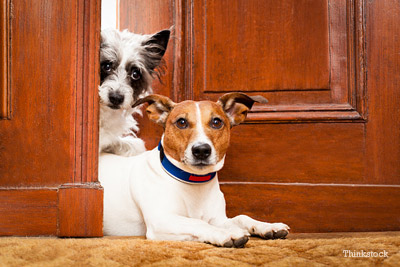With the holidays coming up, your home is likely to be experiencing more activity and guests. Depending on your dog’s personality and habits, this can be a difficult time for both your dog and your family. Planning ahead and doing some simple training with your dog can make this a more pleasant experience for everyone.
Training before the holidays
If you haven’t taught your dog any basic manners or behaviors, now’s the time to start! Even if you’re short on time, you can easily work in short training sessions a few times a day and see results quickly. Work the training into your daily life as much as you can, such as training “stays” while you are cooking in the kitchen, or asking the dog for “sits” and “downs” while you’re on the couch watching TV. The more you ask for behaviors as part of your routine, the more your dog will develop using them as a regular habit. Some of the behaviors that can be most useful during the holidays are:
Sit/Stay – Sit (and stay) is an extremely versatile behavior. You can use it to teach the dog not to jump on visitors at the door, to sit and allow people to greet him, to stay in one place comfortably while you move about the house, and much more. Train your dog to sit and stay in the places he’s most likely to jump up, such as just inside and outside of the front door, in and out of the car, by your kitchen, living room area, or by the back door. Once your dog is doing well, invite friends and neighbors over to practice his sit/stay so he’ll be sitting like a champ when your guests arrive for Thanksgiving dinner!
Go to your place – This is also a wonderful command for dogs that are more boisterous or bother guests at the dinner table or in the living room. Give your dog a place that is “his.” Usually we use a dog bed or mat, or you can use crates as I do with my dogs. Bring your dog to the mat, bed or crate and reward him for being there and laying down/going inside; pair it with a word such as “place” or “crate.” As with the sit/stay, move up to practicing this one with friends and neighbors so the dog has the behavior solid by the time guests will be arriving. Since you want this to be a good experience for your dog, you can give him a nice treat to chew on while he lies on the bed or in their crate. Examples might include a food stuffed toy, a chew stick or something else that your dog loves and can quietly enjoy.
Leave it – Leave it is an indispensable behavior during the holidays. Not only can you use it if the dog decides to go for a delectable human treat on the dining room table, you can also use it on things that dogs are attracted to, such as shiny holiday decorations, holiday plants, and wrapped gifts. Leave it can be generalized to anything once you’ve taught it with food and can help you to tell the dog to move away from something even if you’re at a distance. Another behavior that is often paired with leave it is “drop it” which basically tells the dog to drop an item in their mouths, which is helpful if the dog has grabbed something before you had a chance to use leave it.
Tricks – Okay, while this may not seem like an important behavior, tricks can be a great thing to teach your dog because it gives him something to do. If you have guests coming over who may be a bit nervous about your dog, even if he is friendly, tricks can be a great way to “break the ice.” A dog seems less intimidating when he can shake, high five, spin, roll over or do something equally adorable. If your guests include children, they will most likely be delighted by these behaviors and may even want to teach the dog some themselves, which can be a fun holiday activity (with adult supervision, of course!)
Management during the holidays
The second part of an effective set up for your dog during the holidays is good management.
Keep your dog comfortable— If you know your dog doesn’t care for guests, have a crate ready for him in a quiet spot, such as bedroom with a closed door. Alternatively, keep him in a place where he can feel comfortable and not interact with guests, such as a bedroom, laundry room or other area that is closed off with a door or baby gate. Never allow people to interact with your dog if the dog isn’t comfortable, as this can increase the anxiety he is feeling.
Provide distractions— Have a variety of items ready for your dog, to occupy his time, while you visit with your guests. This can include food stuffed toys or puzzles, bones, chews, chew sticks and toys. Always give your dog an item such as this in a safe place and supervise any interaction if children will be visiting.
Exercise, exercise, exercise— You cannot exercise your dog enough during these busy times. As the saying goes, “A good dog is a tired dog.” The more physical exercise your dog gets, the less rambunctious when people come to visit, and there’s a good chance after greeting guests he’ll be more than happy to crawl up on his bed or crate and take a nap.
If you find you need help with training the behaviors we’ve discussed, you can find professionals near you who can help at www.iaabc.com, www.petprofessionalguild.com and www.apdt.com.
If you have any questions or concerns, you should always visit or call your veterinarian -- they are your best resource to ensure the health and well-being of your pets.
